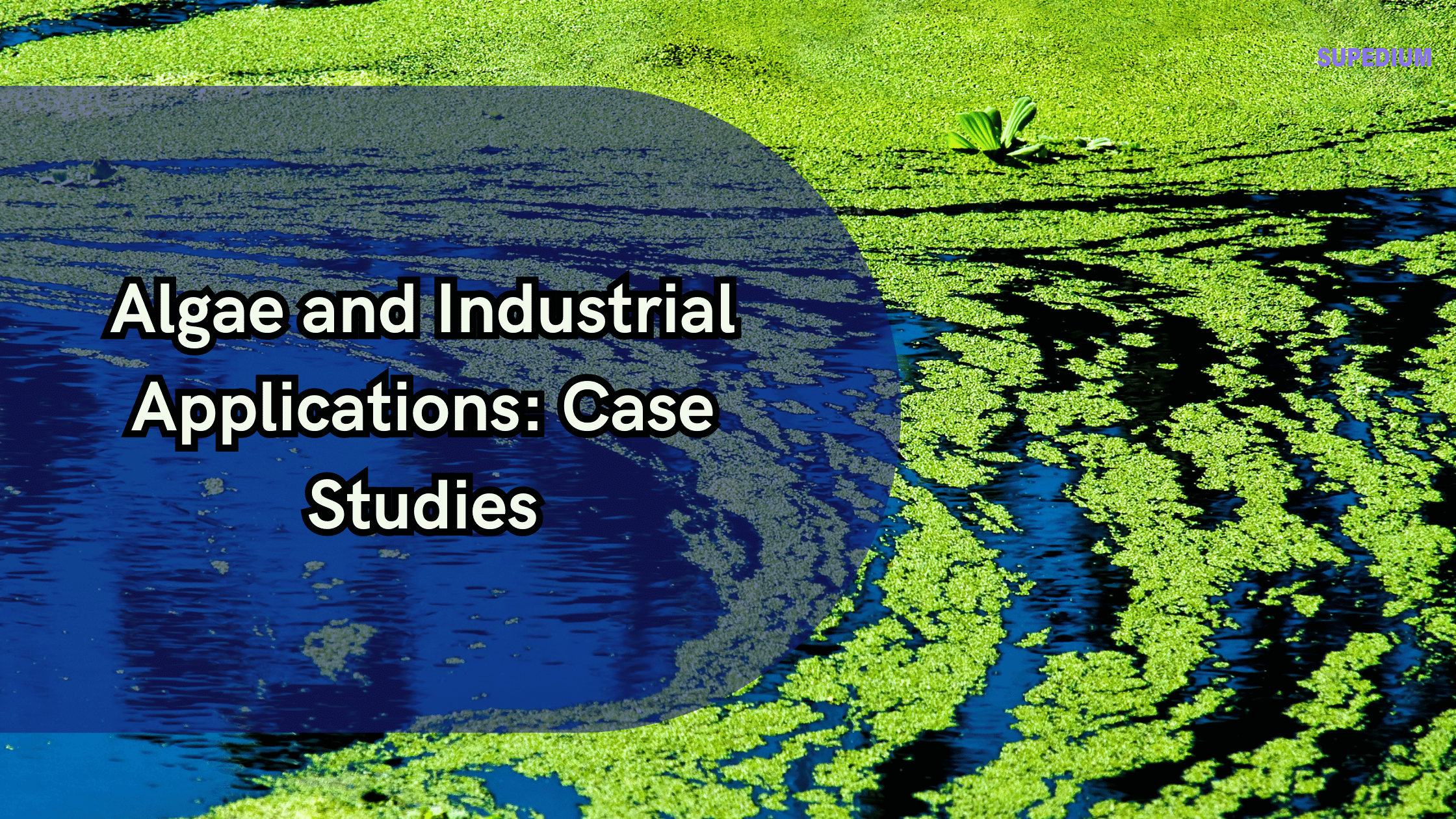Table of Contents
![]()
I. Introduction
Definition and Overview of Algae
Algae are a diverse group of photosynthetic organisms found in various aquatic environments, ranging from freshwater to marine systems. They are classified into two primary categories: microalgae (single-celled organisms) and macroalgae (multicellular organisms like seaweeds). Algae play a crucial role in ecosystems as primary producers and offer numerous industrial applications due to their rich biochemical composition.
Importance of Algae in Industrial Applications
Historically, algae have been utilized for various purposes, including food, medicine, and fertilizers. In recent decades, the potential of algae has expanded significantly with advances in technology and a growing emphasis on sustainability. Algae are now recognized for their applications in biofuels, nutraceuticals, wastewater treatment, agriculture, and carbon sequestration.
Purpose of Case Studies
This article explores the practical applications of algae through detailed case studies. By examining real-world examples, we aim to understand the benefits, challenges, and potential of algae in various industrial sectors.
II. Algae-Based Biofuels
Overview of Algae Biofuels
Algae biofuels, including biodiesel, bioethanol, and biogas, are emerging as viable alternatives to fossil fuels. Algae’s high lipid content and rapid growth rate make it an attractive feedstock for biofuel production. Compared to traditional fuels, algae biofuels offer advantages such as reduced greenhouse gas emissions and lower land use requirements.
Case Study 1: Algae Biofuel Production in the United States
Company Profile: One notable example is Algenol, a U.S.-based company specializing in algae-based ethanol production. Algenol’s technology involves the use of genetically engineered algae strains that convert carbon dioxide and sunlight into ethanol.
Technology and Process: Algenol utilizes photobioreactors to cultivate algae in controlled environments. The algae are engineered to maximize ethanol production, which is then extracted and purified. This process effectively integrates carbon capture with biofuel production.
Economic and Environmental Impact: Algenol’s approach significantly reduces carbon dioxide emissions compared to conventional ethanol production methods. Additionally, the use of non-arable land for algae cultivation minimizes competition with food crops.
Challenges and Solutions: Key challenges include the high cost of photobioreactor systems and the scalability of the technology. Algenol addresses these issues through ongoing research and partnerships aimed at reducing production costs and enhancing efficiency.
Case Study 2: Algae Biofuel in Europe
Regional Focus: In Europe, the European Union-funded project, AQUAEXCEL, focuses on algae biofuel production from microalgae. The project aims to improve the economic viability of algae-based biofuels through advancements in cultivation and harvesting technologies.
Technological Innovations: AQUAEXCEL integrates advanced photobioreactors with innovative harvesting techniques to increase yield and reduce costs. The project also explores the use of waste CO2 from industrial processes as a feedstock for algae cultivation.
Policy and Market Dynamics: European policies, such as the Renewable Energy Directive, support the development of sustainable biofuels. The project’s alignment with these policies helps create a favorable market environment for algae biofuels.
Outcomes and Lessons Learned: AQUAEXCEL has demonstrated the potential for large-scale algae biofuel production in Europe. Lessons learned include the importance of integrated technology solutions and the need for supportive regulatory frameworks.
III. Algae in Nutraceuticals and Pharmaceuticals
Overview of Algae in Health and Wellness
Algae are rich in nutrients such as omega-3 fatty acids, vitamins, and antioxidants, making them valuable for health and wellness products. Nutraceuticals and pharmaceuticals derived from algae have gained popularity due to their potential health benefits.
Case Study 1: Spirulina Production and Use
Company/Research Focus: Cyanotech Corporation, based in Hawaii, specializes in the production of spirulina, a blue-green algae known for its high protein content and nutritional benefits.
Production Methods: Cyanotech employs open-pond systems and controlled environments to cultivate spirulina. The algae are harvested, dried, and processed into dietary supplements and functional foods.
Market Demand and Product Applications: Spirulina supplements are widely used for their potential health benefits, including immune support and enhanced energy levels. The growing consumer demand for natural and organic products drives the market for spirulina.
Regulatory and Quality Assurance Issues: Ensuring product quality and compliance with regulatory standards is crucial. Cyanotech adheres to stringent quality control measures and certifications to maintain high standards.
Case Study 2: Chlorella and its Pharmaceutical Applications
Industry Focus: Chlorella is another microalgae with significant pharmaceutical potential. The Japanese company, Aojiru Co., focuses on developing chlorella-based products for health and medicinal purposes.
Clinical Uses and Research Findings: Chlorella is studied for its potential to improve digestive health, boost the immune system, and support detoxification. Clinical research supports its efficacy in these areas, contributing to its popularity in functional foods and supplements.
Commercialization and Market Strategy: Aojiru Co. markets chlorella in various forms, including tablets, powders, and beverages. The company’s strategy involves leveraging scientific research and consumer education to drive market growth.
Future Prospects: Continued research into the health benefits of chlorella may expand its applications in pharmaceuticals and functional foods, offering new opportunities for industry growth.
IV. Algae in Wastewater Treatment
Role of Algae in Bioremediation
Algae play a crucial role in wastewater treatment by utilizing nutrients and pollutants in the water. Their ability to absorb and transform contaminants makes them effective in bioremediation processes.
Case Study 1: Algae-Based Wastewater Treatment in Asia
Example Location: The Singapore-based company, Hyflux, has implemented algae-based wastewater treatment systems in various projects across Asia.
Implementation Process: Hyflux uses algae to treat municipal and industrial wastewater through integrated algae-based systems. The algae help remove nutrients such as nitrogen and phosphorus while producing biomass that can be recycled.
Environmental and Economic Outcomes: The algae-based systems have demonstrated significant improvements in water quality and reduced operational costs compared to conventional treatment methods. Additionally, the production of algal biomass provides valuable resources for other applications.
Challenges Encountered: Challenges include optimizing algae growth conditions and managing the disposal of excess biomass. Hyflux addresses these issues through technological innovations and ongoing research.
Case Study 2: Algae in Industrial Wastewater Treatment in North America
Company/Facility Profile: In the United States, the company, Algix, focuses on using algae to treat industrial wastewater from sectors such as agriculture and manufacturing.
Technological Approach: Algix employs algae-based photobioreactors to treat wastewater, utilizing the algae’s nutrient uptake capabilities. The treated water is then recycled, and the algal biomass is processed into valuable products.
Results and Benefits: The algae-based system has shown success in reducing pollutants and improving water quality. The integration of wastewater treatment with algae cultivation offers both environmental and economic benefits.
Lessons for Future Projects: Key lessons include the importance of system design and optimization to achieve cost-effective and sustainable wastewater treatment solutions.
V. Algae in Agriculture and Soil Improvement
Use of Algae as Biofertilizers and Soil Conditioners
Algae are used as biofertilizers and soil conditioners to enhance soil health and improve crop yields. Their rich nutrient content and natural growth-promoting substances make them valuable in sustainable agriculture.
Case Study 1: Algae-Based Fertilizers in South America
Farm/Company Profile: In Brazil, the company, Algafuel, produces algae-based fertilizers for use in agricultural operations.
Implementation and Methods: Algafuel utilizes algae to create biofertilizers that enhance soil fertility and crop productivity. The fertilizers are applied to various crops, including grains and vegetables.
Results and Crop Productivity: The use of algae-based fertilizers has led to improved soil health, increased crop yields, and reduced reliance on chemical fertilizers. The positive outcomes support the adoption of algae-based solutions in agriculture.
Environmental Impact: The use of algae-based fertilizers reduces the environmental impact of traditional fertilizers, contributing to more sustainable farming practices.
Case Study 2: Algae in Sustainable Agriculture in Africa
Regional Focus: In Kenya, the project, Algae4Africa, explores the use of algae for sustainable agriculture in smallholder farming systems.
Technology Adoption: Algae4Africa promotes the use of algae-based fertilizers and soil conditioners to enhance crop production and soil health. The project provides training and support to local farmers.
Economic and Social Impacts: The adoption of algae-based solutions has improved food security and livelihoods for smallholder farmers. The project also contributes to environmental conservation and sustainable agriculture practices.
Future Potential and Scalability: The success of Algae4Africa highlights the potential for scaling up algae-based agricultural solutions across Africa, addressing food security and environmental challenges.
VI. Algae in Carbon Sequestration and Environmental Management
Role of Algae in Reducing Greenhouse Gases
Algae contribute to carbon sequestration by absorbing carbon dioxide during photosynthesis. Their ability to capture and store carbon makes them a valuable tool for mitigating climate change.
Case Study 1: Algae-Based Carbon Sequestration Projects in Europe
Example Project: The European project, ALGAE-CAPTURE, focuses on utilizing algae for carbon capture and storage in industrial settings.
Technological Framework: ALGAE-CAPTURE integrates algae cultivation systems with industrial processes to capture CO2 emissions. The algae use the captured CO2 for growth, reducing greenhouse gas emissions.
Results and Impact: The project has demonstrated successful carbon capture and storage, contributing to reduced emissions and enhanced sustainability in industrial operations.
Policy and Regulatory Considerations: European policies, such as the EU Emissions Trading System, support carbon capture and storage initiatives. The project’s alignment with these policies helps create a supportive regulatory environment.
Case Study 2: Coastal Algae for Carbon Management in Asia
Regional Focus: In coastal regions of China, the project, Coastal Algae Carbon Management, explores the use of marine algae for carbon sequestration.
Project Implementation: The project involves cultivating macroalgae in coastal areas to capture carbon and improve coastal ecosystems. The algae’s growth contributes to carbon sequestration and habitat restoration.
Environmental and Economic Outcomes: The project has shown positive environmental impacts, including improved water quality and enhanced biodiversity. Additionally, the economic benefits include the potential for developing new industries based on algae cultivation.
Challenges and Opportunities: Challenges include managing algae growth and integrating carbon management with coastal development. The project identifies opportunities for expanding algae-based carbon management practices.
VII. Challenges and Future Directions
Common Challenges Across Applications
Across various industrial applications, common challenges include high production costs, technological limitations, and regulatory hurdles. Addressing these challenges requires ongoing research, innovation, and collaboration among stakeholders.
Emerging Trends and Innovations
Emerging trends in algae research include advancements in genetic engineering, improved cultivation methods, and integrated processing technologies. Innovations in these areas hold the potential to enhance the efficiency and scalability of algae-based solutions.
Future Prospects for Algae in Industry
The future of algae in industry looks promising, with continued advancements in technology and growing emphasis on sustainability. As research and development progress, algae are likely to play an increasingly important role in addressing global challenges such as energy security, environmental protection, and food security.
VIII. Conclusion
Summary of Key Findings from Case Studies
The case studies presented demonstrate the diverse applications of algae across various industries. Algae offer significant benefits, including environmental sustainability, resource efficiency, and potential economic advantages. However, challenges remain, and addressing these issues is crucial for realizing the full potential of algae-based solutions.
Implications for Industry and Policy
The insights gained from these case studies highlight the need for continued investment in research and development, supportive policies, and collaborative efforts. Industry stakeholders, policymakers, and researchers must work together to overcome challenges and capitalize on the opportunities presented by algae.
Final Thoughts on the Future of Algae in Industrial Applications
Algae have the potential to revolutionize various industrial sectors, offering sustainable solutions to pressing global issues. As technology and research continue to advance, algae are poised to play a crucial role in creating a more sustainable and resilient future.
Share This





Be the first to comment